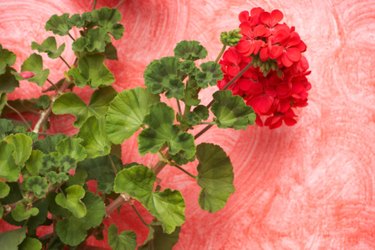
Aphids -- the most common garden pest -- can cause a variety of problems. Not only do these tiny insects suck fluids from your plants' leaves and stems, but they also can promote the spread of disease. Although you can blast aphids away with a spray of water, they can reappear. Discourage these pests with careful companion planting; several varieties of flowering annuals have properties that repel aphids and help protect susceptible flowers.
Aphids
Video of the Day
Aphids are tiny -- rarely exceeding 1/8 inch -- and teardrop shaped, with long, slender legs. Depending on the species, aphids can be green, brown, yellow, red or black, and they are often found congregating on the undersides of leaves. Aphids feed by using their mouth parts to suck fluids from stems and leaves; symptoms of infestation include leaves that are curling, yellowing and misshapen. Honeydew -- the sticky exudate aphids produce -- not only attracts ants, which feed on it, but also promotes the growth of sooty mold, a fungal infection. University of California notes that aphids are also vectors for disease, carrying viruses that can infect plants.
Video of the Day
Marigolds
Marigolds, botanically known as Calendula officinalis, are perhaps the most well-known of the annual plants that repel aphids. Their content of pyrethrin -- a potent natural insecticide -- causes them to be beloved by organic gardeners, who rely on marigolds to send aphids and other pests on their way. Marigolds feature attractive, carnationlike flowers in sunny golds, yellows and oranges, and they bloom in spring, summer and fall. They thrive in full sun and can grow in sandy, loamy or clay soil as long as it is well drained. By deadheading marigolds -- snipping off dead blooms -- you encourage renewed blooming. Although marigolds are superheroes at fending off pests, they can be susceptible to powdery mildew; watch plants closely for this fungal disease.
Geraniums
Geraniums, which feature attractive scalloped leaves and fire engine-red blossoms, help create an unfriendly environment for aphids. They are particularly effective -- visually and as a pest deterrent -- when planted as borders. Geraniums are not picky as to soil pH or type, but it must be porous and well drained; spade an inch or so of coarse peat moss or compost into the bed before planting. These hardy annuals can grow in either full or partial sun and should be fed with a liquid balanced fertilizer. Like marigolds, geraniums have a sharp, distinctive aroma; if you find it disagreeable, scented varieties are available.
Alliums
Allium flowers, which help deter aphids, are actually the blossoms of onions. Despite their earthy pedigree, they make attractive garden occupants. Certain cultivars display attractive spring flowers; one of the most visually pleasing of the ornamental onions, Allium aschersonianum, features a lavender sphere of massed blossoms displayed on stems so slender that the fluffy blooms appear to be levitating in midair. Alliums prefer full sun and fertile, well-drained soil.